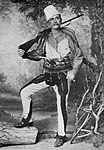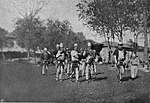Shkreli (stam)

Shkreli, (albanska: Shkreli, bosniska: Skrijelj) är en historisk stam och region i Malsia e Madhe i norra Albanien. Shkreli var en stam som bestod av en enda klan.[1]
Historia[redigera | redigera wikitext]
Shkreli nämns för första gången 1416 som Shkreli.[källa behövs]
Efter den osmanska ockupationen av Albanien emigrerade delar av Shkreli i 1700-talet till Rugova nära Peja, Kosovo och till Sandžak regionen i dagens Montenegro och Serbien. Under tiden konverterade nästan alla till Islam, speciellt de i Sandžak där de även assimilerades och kallar sig i dag för bosnier.[källa behövs]
Antropologi[redigera | redigera wikitext]
Det finns olika teorier om Shkrelis ursprung:
- Enligt Edith Durham kommer de från Bosnien[2]
- Enligt Carleton S. Coon kom de från Bosnien 1600-talet.[3][4][5]
- Enligt Hyacinthe Hecquard kommer de från en albansk famil från Peja, vars ledare hette Kerli.[2]
- Enligt Franz Nopcsa kommer de från Novi Pazar.[6]
Demografi[redigera | redigera wikitext]
I en rapport 1614, skriven av Mariano Bolizza, fanns det 20 hushåll och 43 män redo för strid, ledda a Gjon Porubba.[7]
Galleri[redigera | redigera wikitext]
-
Shkrelis stamledare 1906.
-
Man från Shkreli 1906.
-
Män från Shkreli 1906.
-
Män från Shkreli 1906.
Kända personer från Shkreli[redigera | redigera wikitext]
- Martin Shkreli - amerikansk entreprenör
- Azem Shkreli - kosovansk poet
Referenser[redigera | redigera wikitext]
- ^ Elsie, Robert (2010) (på engelska). Historical Dictionary of Albania. sid. 415
- ^ [a b] The Tribes of Albania:History, Society and Culture. Robert Elsie. sid. 183. https://books.google.se/books?id=i2IpDAAAQBAJ&pg=PA185&dq=berisha+tribe&hl=sv&sa=X&ved=0ahUKEwioiLuQre7OAhVEEiwKHe8YDWsQ6AEIHjAA#v=onepage&q=berisha%20tribe&f=false
- ^ Carl Coleman Seltzer; Carleton Stevens Coon; Joseph Franklin Ewing (1950). The mountains of giants: a racial and cultural study of the north Albanian mountain Ghegs. The Museum. sid. 45. https://books.google.com/books?id=qkXzAAAAMAAJ. Läst 13 maj 2013. ”The people of Shkrelli, comprising a whole bayrak, are said to have come from Bosnia en masse about 1600 and taken over a valley whose inhabitants had been killed off and whose church, Shen Kerli (St. Charles hence Shkrelli) destroyed”
- ^ M. Edith Durham (30 June 2009). High Albania. ECHO LIB. sid. 466. ISBN 978-1-4068-2855-9. https://books.google.com/books?id=AAiokiFpZSMC. Läst 13 maj 2013. ”Skreli is situated in the valley of the Proni Thaat. It is mainly Catholic, and traces its origin from Bosnia.”
- ^ M. Edith Durham (30 June 2009), High Albania, ECHO LIB, s. 454, 455, ISBN 978-1-4068-2855-9, https://archive.org/stream/highalbaniaitscu00durh/highalbaniaitscu00durh_djvu.txt, ”All four of these tribe (Skreli, Hoti, Gruda, Kilmeni) tell that their ancestors came from Bosnia or the Herzegovina, precise district unknown....Skreli and Hoti, which say they come from Bosnia”
- ^ The Tribes of Albania:History, Society and Culture. Robert Elsie. sid. 83. https://books.google.se/books?id=i2IpDAAAQBAJ&pg=PA185&dq=berisha+tribe&hl=sv&sa=X&ved=0ahUKEwioiLuQre7OAhVEEiwKHe8YDWsQ6AEIHjAA#v=onepage&q=berisha%20tribe&f=false
- ^ Early Albania: A Reader of Historical Texts, 11th-17th Centuries. Otto Harrassowitz Verlag. 2003. sid. 147–. ISBN 978-3-447-04783-8. https://books.google.com/books?id=_sHmTRCEe7kC&pg=PA147






